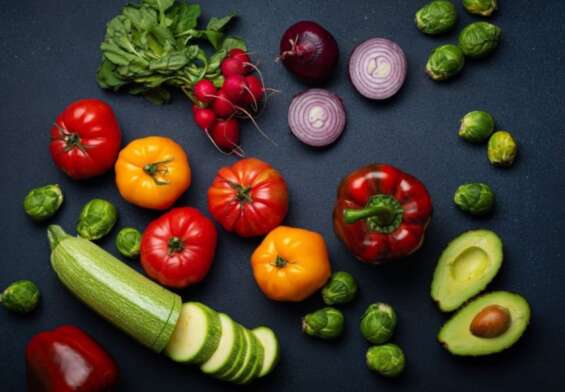
Glycemic Index Diet: The Secret to Healthy Weight Loss!
Glycemic Index (GI) Diet is a nutritional approach designed to help individuals manage their blood sugar levels and improve their overall health. It is based on the glycemic index, which is a ranking system for carbohydrates based on their effect on blood sugar levels. The diet focuses on consuming foods that have a low glycemic index and avoiding foods that have a high glycemic index. This can help people with diabetes or those who are looking to improve their health and nutrition. The GI Diet includes a wide variety of healthy foods, including fruits, vegetables, whole grains, and lean proteins. Eating a balanced diet will help you maintain a healthy weight and prevent long-term health problems.
How the Glycemic Index Diet Can Help You Lose Weight
Are you sick and tired of weight loss diets that are so complex that you need a degree in mathematics to figure them out? Then you should consider the Glycemic Index Diet!
Unlike other diets that involve counting calories, measuring portions, and subtracting fat, the Glycemic Index Diet is surprisingly simple: all you have to do is choose food items with a low Glycemic Index (GI). The GI is a numerical system that measures how quickly a carbohydrate-containing food is digested and absorbed into your bloodstream. Foods with a high GI score, like white bread and potatoes, are quickly absorbed and can cause a spike in your blood sugar levels. On the other hand, foods with a low GI score, like whole wheat bread and oatmeal, are slowly absorbed, which helps keep your blood sugar levels steady.
Not only is the Glycemic Index Diet easy to follow, but it has been scientifically proven to help people lose weight. Studies have shown that people who follow a low GI diet experience greater weight loss than those who follow a traditional calorie-restricted diet. That’s because the low GI diet helps keep you fuller for longer, so you don’t feel the need to snack or overeat.
Plus, it’s also a lot of fun! With the Glycemic Index Diet, you get to explore a whole new world of delicious, healthy foods. So why not give it a try? You may just find yourself losing weight and eating better than ever!
Understanding the Science Behind the Glycemic Index Diet
Are you looking to try something new with your dieting routine? Have you heard of the Glycemic Index Diet? This diet is based on the glycemic index of foods, which measures the effect that a particular food has on your blood sugar levels. But what is the glycemic index, and how does it work? Let’s take a look!
First of all, the glycemic index measures how quickly a food is absorbed into your bloodstream. The higher the number, the faster the food will be absorbed and the higher your blood sugar levels will be. Foods with lower glycemic index numbers will be absorbed slower and have a more gradual effect on your blood sugar levels.
Now, here’s the kicker: the glycemic index diet requires you to eat foods that have a low glycemic index number. That means you’ll be eating foods that are lower in sugar and carbohydrates, like fruits and vegetables. It also means that you’ll be avoiding foods that are high in sugar and carbohydrates, such as white bread, potatoes, and processed foods.
This diet has been proven to be effective in helping you lose weight and maintain a healthy weight. It’s also been linked to lower risks of diabetes, heart disease, and stroke. So, if you’re looking to give your diet an upgrade, the glycemic index diet might be just what you need! Just remember to always consult your doctor before making any major dietary changes.
Foods to Avoid and Foods to Eat on a Glycemic Index Diet
Avoid
- White breads and pastas: “Just because it looks like it tastes good, doesn’t mean it is good for your GI diet!”
- Sugary drinks and treats: “Cut out the soda and candy if you want to stay in line with the GI diet!”
- Fried foods: “No fried chicken, no french fries, no fried anything! Stick to the healthiest version of any food for your GI diet.”
Eat
- Whole grains: “Whole grain breads, pastas, and cereals will fill you up and keep you in line with your GI diet!”
- Fruits and veggies: “Load up on the produce! Fruits and veggies are essential to any diet, especially a GI diet!”
- Lean proteins: “Opt for lean proteins such as fish, poultry, and beans to get your essential nutrients while still following the GI diet!”
The Benefits of Following a Glycemic Index Diet
If you’re looking for a way to get healthier without feeling like you’re missing out on your favorite foods, following a glycemic index diet might be the answer! This diet is based on the concept that different types of carbohydrates have different effects on your blood sugar levels. By following the glycemic index diet, you can enjoy eating the foods you love while still benefiting from their nutritional value. Here are some of the wonderful benefits of following a glycemic index diet:
It’s guilt-free! You don’t have to worry about overeating or feeling guilty about indulging in your favorite treats. The glycemic index diet encourages you to enjoy your food without overdoing it.
You can still enjoy carbohydrates. The glycemic index diet allows you to enjoy carbohydrates in moderation, so you don’t have to give up your beloved pasta and bread.
You’ll feel full longer. Foods with a lower glycemic index take longer to digest, so you’ll stay feeling full for longer.
You don’t have to count calories. You don’t have to worry about counting calories or tracking your intake. The glycemic index diet allows you to enjoy your meals while still staying healthy.
You’ll have more energy. Foods with a lower glycemic index are released into your bloodstream more slowly, which means you’ll have more energy throughout the day.
You can eat healthier without feeling like you’re missing out. The glycemic index diet encourages you to eat nutritious foods without sacrificing your favorite treats.
There you have it! The glycemic index diet is a great way to get healthier without feeling like you’re missing out. So, why wait? Give it a try and see how great you feel!
Meal Planning Tips for a Glycemic Index Diet
Get creative with your ingredients! Low-GI foods don’t have to be boring. Try experimenting with new flavors and textures to keep your meals interesting.
Spice it up! Adding herbs and spices to your meals can help you reduce your craving for sweet, high-GI foods.
Don’t forget about breakfast! Starting the day with a low-GI breakfast is a great way to kick start your day and keep your blood sugar levels steady. Try a bowl of oatmeal or a piece of whole wheat toast with peanut butter.
Make it a habit! Plan your meals ahead of time so you don’t find yourself reaching for unhealthy snacks.
Don’t forget about snacks! Healthy snacks like nuts, fruits, and vegetables will help you stay full between meals.
Get creative with breakfast! Try some savory oatmeal or a vegetable omelet instead of sugary cereals.
Substitute! Replace high-GI foods like white bread and white rice with low-GI options like whole grain bread and brown rice.
Get your fat fix! Healthy fats like olive oil, nuts, and avocado are great sources of energy and are essential to a healthy diet.
Don’t forget about protein! Protein-rich foods like lean meats, eggs, and legumes are essential for a balanced diet.
Have fun! Enjoy your meals and keep experimenting with new recipes.
How to Incorporate Low Glycemic Index Foods into Your Diet
If you’re looking to incorporate low glycemic index (GI) foods into your diet, then don’t worry, you’ve come to the right place! Here you’ll find all the information you need to make your meals as delicious as they are healthy. So, let’s get started.
First off, what is the low GI diet? Basically, it’s a way of eating that focuses on foods with a lower glycemic index. This means that they’ll take longer to digest, which will help keep your blood sugar levels stable and help you stay full for longer. Plus, it’s an easy way to make sure you’re getting plenty of nutritious, fiber-filled foods.
Now, let’s talk about what foods you should be adding to your plate. Some great low GI picks include vegetables like broccoli, cauliflower, and Brussels sprouts, as well as fruits like kiwi, apples, and oranges. Other great choices include legumes like lentils and beans, whole grains like quinoa and barley, and nuts and seeds.
When it comes to meal ideas, the possibilities are endless! Try adding some of your low GI ingredients to salads, soups, and stir-fries. Or, if you’re feeling adventurous, you can even make your own low GI pizzas and pastas.
Of course, there’s no need to give up your favorite dishes either. Simply swap out some of the higher GI ingredients for lower GI alternatives. For example, switch white rice for brown rice or white bread for whole grain bread.
So there you have it – your guide to incorporating low GI foods into your diet. Now, get out there and enjoy some delicious, nutritious meals!
The Pros and Cons of Following a Glycemic Index Diet
Pros
- You’ll never have to guess what to eat for dinner ever again – just pick something with a low glycemic index rating!
- You’ll be the envy of all your carb-loving friends as you indulge in endless amounts of delicious, low-GI food.
- You’ll never have to worry about the dreaded “carb crash” – when you’re following a low-GI diet, your blood sugar levels stay steady, giving you sustained energy throughout the day.
Cons
- You’ll have to say goodbye to all of your favorite high-GI foods like donuts, french fries, and ice cream.
- You may start to develop a fear of bread, pasta, and other carbohydrate-rich foods.
- You may find yourself always checking the glycemic index of every food you eat – at restaurants, in the supermarket, and even at your friends’ houses!
How to Read Glycemic Index Food Labels
If you’ve ever looked at a food label and felt like you were reading a foreign language, you’re not alone. Glycemic index (GI) labels can be incredibly confusing, but don’t worry. We’re here to help you decode them so you can make informed food choices.
First things first: What is the glycemic index? It’s a measure of how quickly and how much a food can raise your blood sugar levels. The higher the GI, the faster your blood sugar will spike.
Ready to get started? Here’s a fun way to read a glycemic index food label:
Step 1: Find your starting point
Look for the glycemic index (GI) number, which is usually at the top of the label. The higher the number, the quicker the food will raise your blood sugar.
Step 2: Measure the GI
This number should be between 0 and 100. If it’s 70 or more, the food is considered high-GI. If it’s 55 or less, it’s low-GI. Anything in between is considered medium-GI.
Step 3: Check the serving size
This is especially important with high-GI foods, since they can have a huge impact on your blood sugar levels. Make sure you’re eating the right amount of the food.
Step 4: Read the label carefully
Look for other words that might help you determine the GI of the food, like “refined” or “whole grain.” These can make a big difference in the GI number.
Step 5: Enjoy!
Now that you’ve deciphered the glycemic index label, you can enjoy your food knowing you’ve made an informed choice.
There you have it — decoding glycemic index labels doesn’t have to be difficult! With a little practice, you’ll be a GI pro in no time.
How to Use Glycemic Index Ratings to Manage Blood Sugar
Are you looking to manage your blood sugar with the help of the glycemic index? Well, you’ve come to the right place! Here are some tips to help you get started:
Check the Glycemic Index: Start by familiarizing yourself with the Glycemic Index. This is a system that ranks carbohydrate-containing foods from 0 to 100 based on how quickly they raise your blood sugar levels. The higher the number, the faster your blood sugar will spike.
Choose Foods With Lower Ratings: Aim to select foods with lower ratings on the Glycemic Index. These are typically whole grains, legumes, fruits, and vegetables. These foods will help you keep your blood sugar levels stable for longer.
Combine High and Low Glycemic Index Foods: If you’re having a meal that contains higher glycemic index foods, make sure to pair them with lower glycemic index foods. This helps to slow down the absorption of sugar into the bloodstream.
Eat Smaller Portions: It’s important to keep portions small when eating high glycemic index foods. Eating too much of these foods can lead to a rapid spike in blood sugar levels.
Have Fun With It: Finally, have some fun with it! Don’t be afraid to experiment with different combinations of foods. You might just discover some delicious and healthy meals that help you keep your blood sugar levels stable.
So there you have it! With these tips, you can use the Glycemic Index to manage your blood sugar levels. Good luck and happy eating!
Common Mistakes to Avoid When Following a Glycemic Index Diet
Not Eating Enough Fruits and Veggies: Eating too few fruits and vegetables can cause you to miss out on essential vitamins, minerals, and fiber. So make sure to fill your plate with plenty of fresh produce!
Overindulging in High-GI Foods: Just because a food has a high GI doesn’t mean you can eat as much as you want. Stick to moderate amounts, and opt for more low-GI options.
Not Eating Enough Complex Carbs: Complex carbs, like whole grains and legumes, help to provide sustained energy throughout the day. Don’t forget to include them in your diet!
Going Overboard on Protein: Too much protein can kick your body out of ketosis, so be sure to regulate the amount of protein you’re eating.
Ignoring Portion Sizes: A key part of following a GI diet is to watch your portion sizes. Even healthy foods can pack in too many calories if you’re not careful.
Not Reading Labels: Not all foods labeled “low-GI” are actually low-GI, so make sure to read labels before you buy.
Not Getting Enough Exercise: Exercise helps to regulate your blood sugar levels and keeps your body in balance. Don’t forget to get your daily dose of activity!
Tips for Sticking to a Glycemic Index Diet Long Term
Make sure to keep a variety of low-glycemic index foods on hand. This will help prevent boredom and keep you motivated.
Find low-glycemic index recipes and experiment in the kitchen. Not only will this keep things interesting, but it can also help you stay on track and avoid unhealthy alternatives.
Reward yourself for sticking to the plan. A small treat every now and then can help you stay focused and motivated.
Join a support group or look for online resources. Having a support system can make all the difference.
Don’t be afraid to mix it up. Eating the same foods every day can get boring. Try new recipes, ingredients, and flavors to keep it fresh.
Plan ahead and make sure you always have healthy snacks on hand. This will help you avoid those unhealthy snacks that can derail your plan.
Be realistic. Don’t expect to be perfect. It’s okay to slip up every now and then. Just remember to get back on track as soon as possible.
Get creative. Try to come up with new ways to enjoy your low-glycemic index foods. You can even make a game out of it!
Have fun! Don’t let the diet become a chore. A positive attitude will help you stick with it long term.
Conclusion
The Glycemic Index Diet is a popular nutrition plan that can be beneficial for those looking to manage their blood sugar levels and maintain a healthy lifestyle. By focusing on foods that have a low glycemic index, this diet can help individuals regulate their blood sugar levels and reduce the risk of developing chronic health issues associated with diabetes and other metabolic disorders. Ultimately, the Glycemic Index Diet can serve as a helpful tool for individuals looking to improve their overall health and wellbeing.











